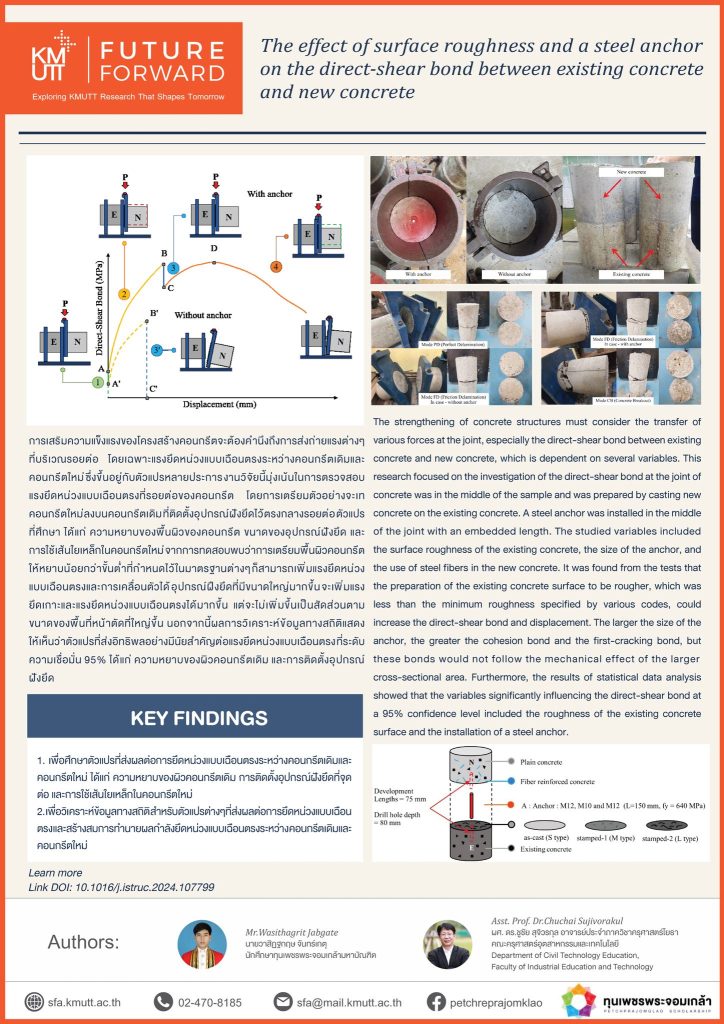การเสริมความแข็งแรงของโครงสร้างคอนกรีตจะต้องคำนึงถึงการส่งถ่ายแรงต่างๆ ที่บริเวณรอยต่อ โดยเฉพาะแรงยึดหน่วงแบบเฉือนตรงระหว่างคอนกรีตเดิมและคอนกรีตใหม่ ซึ่งขึ้นอยู่กับตัวแปรหลายประการ งานวิจัยนี้มุ่งเน้นในการตรวจสอบแรงยึดหน่วงแบบเฉือนตรงที่รอยต่อของคอนกรีต โดยการเตรียมตัวอย่างจะเทคอนกรีตใหม่ลงบนคอนกรีตเดิม ที่ติดตั้งอุปกรณ์ฝังยึดไว้ตรงกลางรอยต่อ ตัวแปรที่ศึกษา ได้แก่ ความหยาบของพื้นผิวของคอนกรีต ขนาดของอุปกรณ์ฝังยึด และการใช้เส้นใยเหล็กในคอนกรีตใหม่ จากการทดสอบพบว่าการเตรียมพื้นผิวคอนกรีตให้หยาบน้อยกว่าขั้นต่ำที่กำหนดไว้ในมาตรฐานต่างๆ ก็สามารถเพิ่มแรงยึดหน่วงแบบเฉือนตรงและการเคลื่อนตัวได้ อุปกรณ์ฝึงยึดที่มีขนาดใหญ่มากขึ้น จะเพิ่มแรงยึดเกาะและแรงยึดหน่วงแบบเฉือนตรงได้มากขึ้น แต่จะไม่เพิ่มขึ้นเป็นสัดส่วนตามขนาดของพื้นที่หน้าตัดที่ใหญ่ขึ้น
นอกจากนี้ผลการวิเคราะห์ข้อมูลทางสถิติแสดงให้เห็นว่าตัวแปรที่ส่งอิทธิพลอย่างมีนัยสำคัญต่อแรงยึดหน่วงแบบเฉือนตรง ที่ระดับความเชื่อมั่น 95% ได้แก่ ความหยาบของผิวคอนกรีตเดิม และการติดตั้งอุปกรณ์ฝังยึด
The strengthening of concrete structures must consider the transfer of various forces at the joint, especially the direct-shear bond between existing concrete and new concrete, which is dependent on several variables. This research focused on the investigation of the direct-shear bond at the joint of concrete was in the middle of the sample and was prepared by casting new concrete on the existing concrete. A steel anchor was installed in the middle of the joint with an embedded length. The studied variables included the surface roughness of the existing concrete, the size of the anchor, and the use of steel fibers in the new concrete. It was found from the tests that the preparation of the existing concrete surface to be rougher, which was less than the minimum roughness specified by various codes, could increase the direct-shear bond and displacement. The larger the size of the anchor, the greater the cohesion bond and the first-cracking bond, but these bonds would not follow the mechanical effect of the larger cross-sectional area. Furthermore, the results of statistical data analysis showed that the variables significantly influencing the direct-shear bond at a 95% confidence level included the roughness of the existing concrete surface and the installation of a steel anchor.
![]() 𝗞𝗘𝗬 𝗙𝗜𝗡𝗗𝗜𝗡𝗚𝗦
𝗞𝗘𝗬 𝗙𝗜𝗡𝗗𝗜𝗡𝗚𝗦![]()
1. เพื่อศึกษาตัวแปรที่ส่งผลต่อการยึดหน่วงแบบเฉือนตรงระหว่างคอนกรีตเดิมและคอนกรีตใหม่ ได้แก่ ความหยาบของผิวคอนกรีตเดิม การติดตั้งอุปกรณ์ฝังยึดที่จุดต่อ และการใช้เส้นใยเหล็กในคอนกรีตใหม่
2. เพื่อวิเคราะห์ข้อมูลทางสถิติ สำหรับตัวแปรต่างๆที่ส่งผลต่อการยึดหน่วงแบบเฉือนตรง และสร้างสมการทำนายผลกำลังยึดหน่วงแบบเฉือนตรงระหว่าง คอนกรีตเดิมและคอนกรีตใหม่


